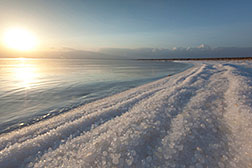- Number 415 |
- June 9, 2014
Fungus offers clues toward salt-tolerant crops

Dead Sea, Israel.
(Image by Itamar Grinberg)
As climate change continues to affect agricultural lands and yields, some researchers are looking at improving crops to make them more tolerant of drier and saltier conditions. Toward this end, a team including researchers from the DOE Joint Genome Institute and the University of Haifa in Israel studied the genome of a fungus (Eurotium rubrum) that thrives in the Dead Sea, describing their findings in the May 9, 2014 issue of Nature Communications.
The DOE JGI team sequenced, assembled and annotated the 26.2-million base genome of E. rubrum. They found that the E. rubrum proteins had higher aspartic and glutamic acid amino acid levels than expected. After comparing E. rubrum’s gene families against those in two other halophilic species, they noted that high acidic residues were a general trait all salt-tolerant microbes share. Researchers from the University of Haifa then focused on the fungus’ tolerance for salt, growing samples in liquid and solid media at salinities from zero percent up to 90 percent of Dead Sea water. They found that E. rubrum had viable spores when grown in 70 percent diluted Dead Sea water, conditions equivalent to an algal bloom in the Dead Sea 20 years ago.
The team reported that the genes and mechanisms they found related to how the fungus has adapted to survive in the Dead Sea ecosystem could serve as targets in developing crops that can tolerate what are currently considered stressful growth conditions. Read more at http://jgi.doe.gov/salt-needed-tolerance-lessons-from-a-dead-sea-fungus/.[Massie Ballon, 925.927.2541,
mlballon@lbl.gov]
